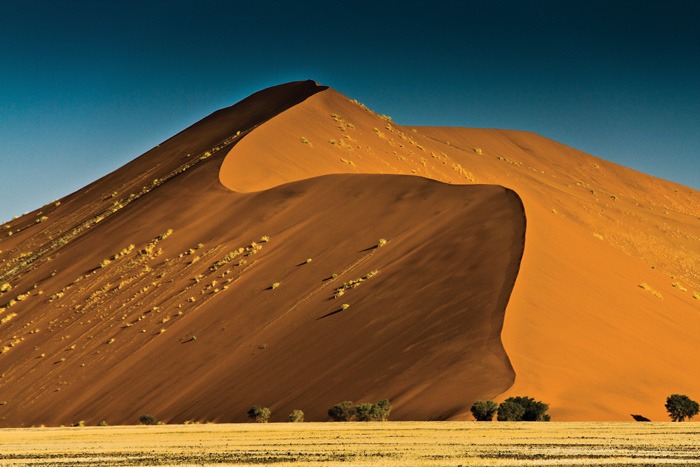Rock Art in the Namibian Wilderness
- Windhoek Hosea Kutako International Airport, Namibia
- Culture & Nature

| from £4,995* per person | 15 Days | September, October |
| Comfort accommodations | Exertion level: 3 | |
| Operator: Andante Travels | 12 people max | |
The unique opportunity which is afforded by the rock art sites in Namibia is that of being able to understand the world around you through material which is thousands of years old. There is an engaging process of association between living groups of people and those depicted in the art, and between the wildlife and ecology, and those represented in the paintings. The landscape in which the rock art has survived is pristine and unmanaged. We will be driving through an environment little changed from that which our early ancestors would have known.
The exceptional plant and animal life has specially adapted to cope with the climatic extremes of Namibia. From the forbidding Skeleton Coast where giant sand mountains rise directly from the ocean to the greener bush of the upland plateau, some of the rarest plants in the wold survive, such as the underground tree.
Loading map, please wait...
Locations visited/nearby
Namibia, Africa
Itinerary
Day OneFly from London.
Day Two
Arrive in Windhoek and drive to hotel. Depending on flight times, visit Windhoek Museum, with examples of the earliest art in Namibia, today or at end of the tour.
Day Three
Morning arrival to begin the drive west. We pass through the stunning scenery of the Kuiseb Valley and across the Namib desert to our first hotel in Swakopmund.
Day Four
A morning in the Swakop River, studying the flora and fauna. This is the best introduction to some of the remarkable aspects of the Namib. Optional afternoon private flight over Sossusvlei and the Namib Desert with its dune fields or a dolphin-spotting cruise.
Day Five
An early start north along the Skeleton Coast, and thence inland to the spectacular beauty of the Spitzkoppe Mountains, granite lances which rise sheer from the plain. We see a number of sites dating to about 100,000 years ago. Continue through the spectacular Erongo Mountains to our lodge outside Omaruru.
Day Six
Full day in the Erongo Mountains at Omandumbu West. Visit a number of painting sites, few of which have ever been recorded. Some are complex interplays of dozens of animal and human figures; others allow great insight into the meaning of the paintings, and the world of the San (bushman) people.
Day Seven
Morning drive to the Brandberg Range, where there are thousands of mural art sites amid some of the most photogenic scenery in Africa. Visit the "White Lady" shelter (45 min walk), with its complex mural designs including the most famous rock art in southern Africa. Continue to the Twyfelfontein area.
Day Eight
The table mountains of Damaraland form an outstanding panorama. Morning visit to the famous petroglyph (rock-carving) site of Twyfelfontein, one of the primary sites for rock engravings. Afternoon tracking desert animals in the Huab River.
Day Nine
A full day game viewing in the Etendeka. As well as the starkly attractive views, there is a variety of wildlife in this rugged setting. Drive north to the Border between the Kaokoland and Damaraland, to our Lodge for the evening.
Day Ten
Early morning start, a short drive north to visit a local Himba village. Depart via the small town of Sesfontein into the lower Hoanib in search of desert elephant and various other desert adapted wildlife. Late afternoon return to our lodge.
Day Eleven
Drive east through the breath-taking Khowarib Schlucht to the western edge of the Etosha National Park for overnight stay.
Day Twelve
The Etosha Pan is one of the largest game reserves in southern Africa and gives an ideal opportunity to study the environmental background to large mammals in the African landscape. Overnight at a Rest Camp by a watering hole, where it is not uncommon to see Black Rhino, elephant and lion. Overnight at Okaukeujo.
Day Thirteen
A full day game drive through the main part of the great pan. African elephant, mountain and plains zebra, giraffe and other animals congregate at the water holes, sometimes in large numbers. There is an abundance of bird life here too.
Day Fourteen
Drive south to the Waterberg Plateau and the reserve at Okonjima, famous for its “Africat” programme. Afternoon watching leopard and cheetah, for which Okonjima is world famous. Overnight at Okonjima.
Day Fifteen
Morning at Okonjima before afternoon drive to Windhoek airport.
Day Sixteen
Early morning arrival in the UK.
More information from Andante Travels:
- View trip on provider's website
www.andantetravels.com/… - Company profile, experience, and history
- View all of their trips
- Email this trip page to a friend
-



Comments from Facebook